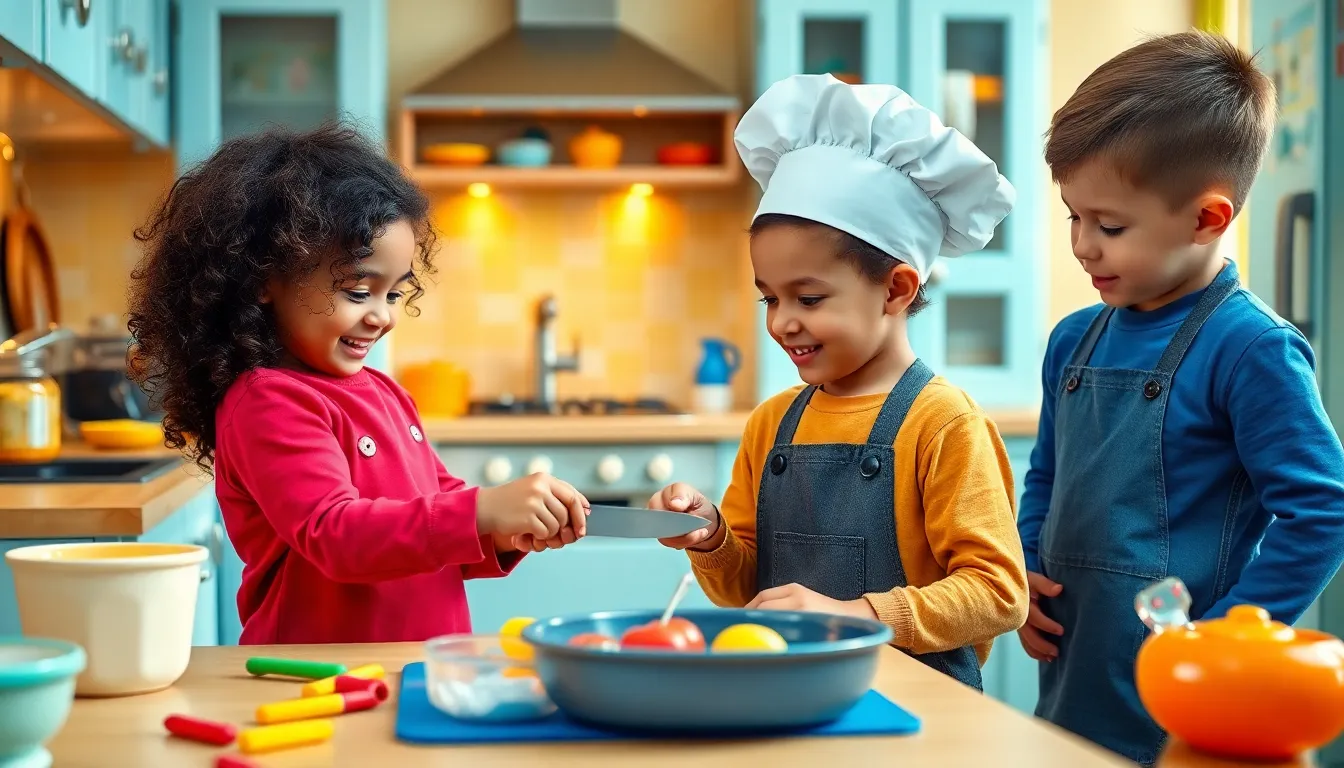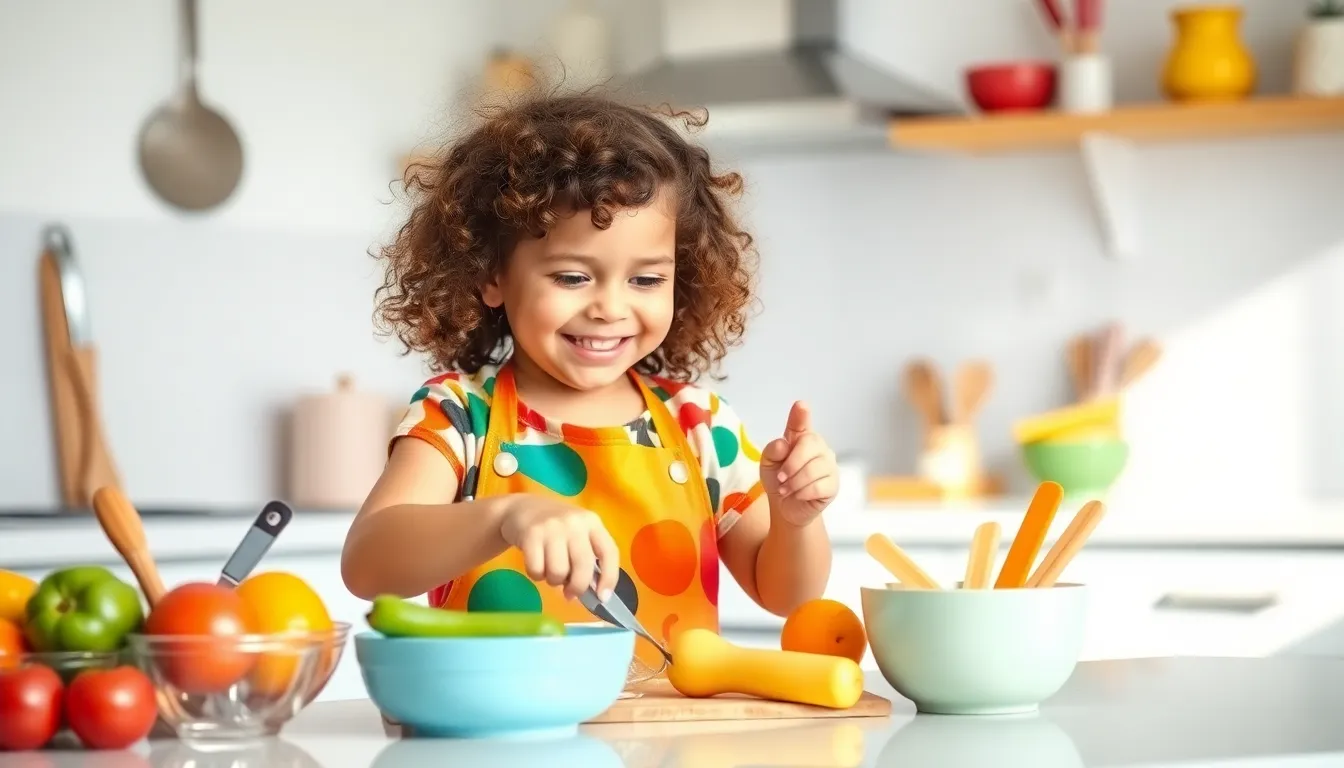Getting kids involved in the kitchen can be a delightful experience, but it often comes with its own set of challenges. From messy spills to safety concerns, cooking with little ones can feel overwhelming. However, with the right kid-friendly kitchen hacks, parents can turn cooking time into a fun and educational adventure.
These simple tricks not only make the cooking process smoother but also encourage creativity and independence in children. Whether it’s using colorful utensils or creating easy-to-follow recipes, these hacks transform the kitchen into a playful learning environment. Discovering how to engage kids in cooking can foster lifelong skills and a love for healthy eating.
Table of Contents
ToggleKid-Friendly Kitchen Hacks Overview
Kid-friendly kitchen hacks transform cooking into an enjoyable and educational activity. These practical tricks simplify various tasks, making it safer and more engaging for children. Here are some effective hacks to consider:
- Color-Coded Utensils: Use utensils in bright colors to capture children’s attention. These tools help kids associate specific tasks with designated items, promoting organization.
- Pre-Cut Ingredients: Prepare and organize ingredients before cooking. Pre-cut vegetables and fruits minimize preparation time, allowing kids to focus on the cooking process rather than the chopping.
- DIY Measuring Tools: Create measuring cups from empty yogurt containers or similar items. This encourages kids to get hands-on experience with portioning while maintaining a fun, experimental atmosphere.
- One-Pot Recipes: Choose one-pot recipes to reduce cleanup. These simple dishes minimize mess and allow children to enjoy the cooking and eating process without overwhelming them.
- Interactive Cooking Stations: Set up separate cooking stations for kids to explore. Providing different tasks, like mixing or assembling, encourages creativity and teamwork.
- Edible Decorations: Supply edible decorations, like fruits or nuts, for personalizing dishes. Kids can express their creativity by designing their meals, making culinary tasks more enjoyable.
- Timer Challenges: Introduce a timer for cooking tasks to create a fun challenge. Kids can compete against the clock, enhancing their sense of accomplishment when they complete tasks successfully.
Integrating these hacks fosters a positive cooking experience, encouraging children to embrace culinary skills and healthy eating habits while making lasting memories in the kitchen.
Safety First

Involving children in cooking requires a strong focus on safety. Implementing certain precautions ensures a secure environment for learning and creativity.
Childproofing the Kitchen
Childproofing the kitchen minimizes hazards and creates a safe space for kids.
- Cabinet Locks: Install cabinet locks on areas containing sharp objects and cleaning supplies to prevent access.
- Stove Guards: Use stove guards or covers to protect children from accidental burns or injuries while cooking.
- Non-Slip Mats: Place non-slip mats near sinks and prep areas to reduce the risk of slips and falls.
- Child-Sized Utensils: Offer child-sized utensils tailored for small hands, promoting control and decreasing the chances of accidents.
Safe Cooking Practices
Establishing safe cooking practices enhances the overall kitchen experience for children.
- Supervision: Always supervise young children closely during cooking activities, ensuring safety and guidance.
- Proper Knife Handling: Teach children to use knives safely, starting with plastic or butter knives for cutting soft foods.
- Safe Hygiene: Emphasize handwashing before and after food preparation to prevent illnesses and maintain cleanliness.
- Avoiding Hot Surfaces: Instruct children to stay clear of hot surfaces and appliances, explaining the reasons behind it for better understanding.
- Fire Safety: Educate children about fire safety, ensuring they know what to do in case of a kitchen fire, including how to use a fire extinguisher.
Fun and Easy Recipes
Creating fun and easy recipes makes cooking enjoyable for kids. Here are some delightful suggestions that encourage creativity and teamwork.
No-Bake Treats
No-bake treats allow kids to explore their culinary skills without using heat. Recipes like chocolate-covered pretzels, fruit skewers, and yogurt parfaits are easy and quick.
- Chocolate-Covered Pretzels: Melt chocolate chips, dip pretzels, and let them cool on wax paper. Kids can add sprinkles for an extra touch.
- Fruit Skewers: Choose colorful fruits like grapes, strawberries, and melon. Use wooden skewers to build personalized creations.
- Yogurt Parfaits: Layer yogurt, granola, and fresh fruits in clear cups. Kids can customize by selecting their favorite ingredients.
Simple Cooking Projects
Simple cooking projects introduce kids to basic kitchen skills while keeping them engaged. Recipes that require minimal preparation work best.
- Mini Pizzas: Use English muffins or pita bread as bases. Kids can spread sauce and sprinkle cheese, then customize with toppings of choice.
- Smoothie Bowls: Blend frozen fruits and yogurt to create smoothie bowls. Children can decorate with toppings like seeds, nuts, and sliced fruits.
- Vegetable Quesadillas: Fill tortillas with cheese and chopped vegetables. Kids can assemble their quesadillas and help with flipping once done.
These recipes not only enhance children’s cooking skills but also make for enjoyable family activities.
Engaging Kids in Meal Prep
Involving children in meal preparation offers numerous learning opportunities. Assigning tasks based on age enhances their engagement and fosters creative thinking in the kitchen.
Age-Appropriate Tasks
- Toddlers (2-4 years): Toddlers can assist with washing fruits and vegetables. They can also mix ingredients in a bowl using kid-friendly utensils.
- Preschool (4-5 years): Preschoolers can help by tearing leaves for salads or rolling dough. They can also learn to count ingredients, introducing basic math skills.
- Early Elementary (6-8 years): Children at this age can handle simple tasks like measuring ingredients, spreading sauce on bread, or stirring pots. They can practice knife skills with supervision while working on soft ingredients.
- Older Children (9 years and up): Older kids can take on more complex responsibilities such as following simple recipes independently or using the oven with guidance. They can learn to create their own dishes, enhancing culinary confidence.
Encouraging Creativity
- Creative Plating: Encouraging kids to arrange food in fun shapes or colorful patterns makes meals visually appealing. Use cookie cutters for fun shapes or let them decorate their plates with sauces.
- DIY Inventories: Allow kids to create their own recipes by selecting ingredients from pre-prepared options. This promotes decision-making and creativity in flavor combinations.
- Themed Cooking Nights: Organize cooking nights with themes like “Taco Night” or “Pizza Party.” This approach invites kids to explore various flavors and cuisines while engaging in fun activities.
- Interactive Challenges: Introduce cooking challenges where kids can experiment with spices or unusual ingredients. Rewarding creativity boosts confidence and motivates them to try new things.
Employing these strategies enhances children’s engagement in meal prep, fostering a productive and enjoyable kitchen environment.
Time-Saving Tips for Busy Families
Families can benefit from implementing time-saving hacks in the kitchen. These strategies enhance efficiency, making cooking a more enjoyable experience for everyone involved.
Quick Clean-Up Hacks
- Use Liners: Employ silicone or disposable baking liners to minimize cleanup time. Simply remove the liners after use for a quick clean.
- Set Up a Garbage Bowl: Designate a bowl for scraps during prep. This keeps surfaces tidy and speeds up trash disposal after cooking.
- Soak Dishes: To tackle tough stains, soak pots and pans in hot, soapy water right after use. This reduces elbow grease needed later.
- Employ the Dishwasher: Load dishes, utensils, and cutting boards into the dishwasher after meals to ensure sanitized kitchenware without extra effort.
- Schedule Cleanup Time: Create a post-meal cleanup routine for kids. Assign age-appropriate tasks, allowing children to help while learning responsibility.
Meal Planning Strategies
- Plan Weekly Menus: Outline meals for the week every Sunday. Include input from family to encourage excitement about upcoming dishes.
- Double-Up on Ingredients: Cook larger batches of versatile ingredients like grains and proteins. Store leftovers for quick meals on busy nights.
- Incorporate Theme Nights: Assign themes such as Taco Tuesday or Pasta Night. Simplifying meal ideas enhances creativity and minimizes decision fatigue.
- Prepare Freezer Meals: Assemble and freeze meals in advance for easy access on hectic days. Include detailed labels for guided cooking instructions.
- Utilize Apps or Planners: Explore meal planning apps to organize recipes and grocery lists efficiently. This streamlines shopping and cooking logistics, saving time overall.
Embracing kid-friendly kitchen hacks transforms cooking into a delightful and educational experience for children. These strategies not only enhance creativity and independence but also foster a love for healthy eating. By integrating safety measures and engaging tasks, parents can create a secure environment that encourages kids to explore their culinary skills.
The joy of cooking together builds lasting memories and strengthens family bonds. With the right tools and fun recipes, families can enjoy quality time while teaching valuable life skills. Ultimately, these hacks make the kitchen a vibrant space for learning and growth, ensuring that children develop a lifelong appreciation for cooking.





